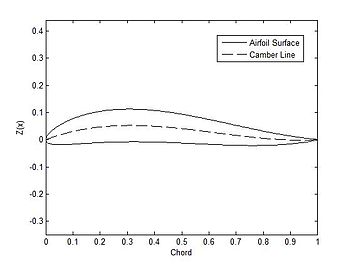In aeronautics and aeronautical engineering, camber is the asymmetry between the top and the bottom surfaces of an aerofoil. An aerofoil that is not cambered is called a symmetric aerofoil.
Camber is usually designed into an aerofoil to increase the maximum lift coefficient. This minimizes the stalling speed of aircraft using the aerofoil. Aircraft with wings based on cambered aerofoils usually have lower stalling speeds than similar aircraft with wings based on symmetric aerofoils.
Some recent designs use negative camber. One such design is called the supercritical aerofoil. It is used for near-supersonic flight, and produces a higher lift to drag ratio at near supersonic flight than traditional aerofoils. Supercritical aerofoils employ a flattened upper surface, highly cambered (curved) aft section, and greater leading edge radius as compared to traditional aerofoil shapes. These changes delay the onset of wave drag.
source-wikipedia.org
Camber is usually designed into an aerofoil to increase the maximum lift coefficient. This minimizes the stalling speed of aircraft using the aerofoil. Aircraft with wings based on cambered aerofoils usually have lower stalling speeds than similar aircraft with wings based on symmetric aerofoils.
Some recent designs use negative camber. One such design is called the supercritical aerofoil. It is used for near-supersonic flight, and produces a higher lift to drag ratio at near supersonic flight than traditional aerofoils. Supercritical aerofoils employ a flattened upper surface, highly cambered (curved) aft section, and greater leading edge radius as compared to traditional aerofoil shapes. These changes delay the onset of wave drag.
Definition
The camber of an aerofoil can be defined by a camber line, which is the curve that is halfway between the upper and lower surfaces of the aerofoil. Call this function Z(x). To fully define an aerofoil we also need a thickness function T(x), which describes the thickness of the aerofoil at any given point. Then, the upper and lower surfaces can be defined as follows:Example – An aerofoil with reflexed camber line
An aerofoil where the camber line curves back up near the trailing edge is called a reflexed camber aerofoil. Such an aerofoil is useful in certain situations, such as with tailless aircraft, because the moment about the aerodynamic center of the aerofoil can be 0. A camber line for such an aerofoil can be defined as follows (note that the lines over the variables indicates that they have been nondimensionalized by dividing through by the chord):source-wikipedia.org



![\overline{Z}(x) = a\left[\left(b-1\right)\overline{x}^3-b\overline{x}^2+\overline{x}\right]](http://upload.wikimedia.org/math/2/5/e/25ec8d41a46606a1834c50a1d2b8f7f7.png)
